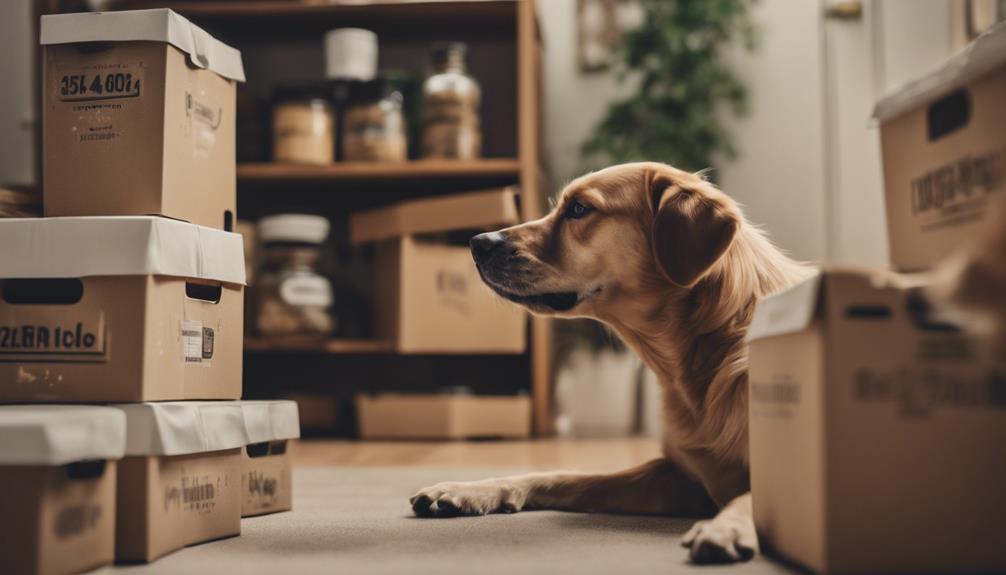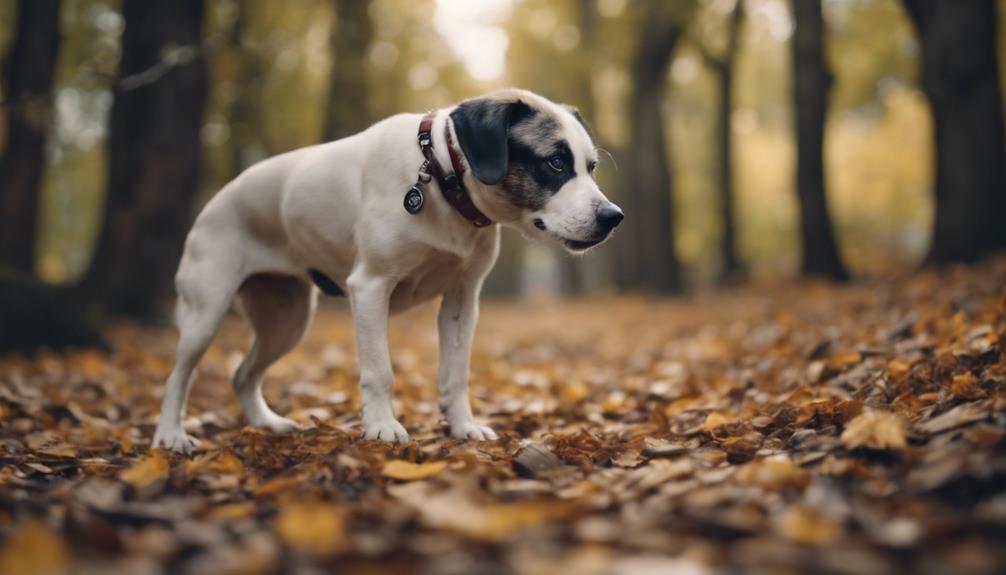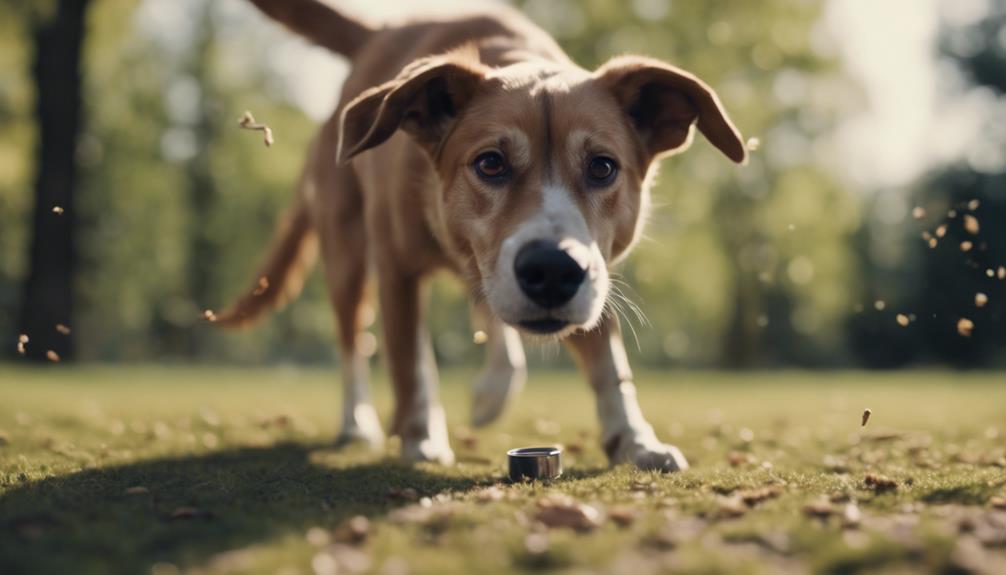In the realm of canine training, scent work has emerged as a captivating field that taps into dogs' remarkable sense of smell. By honing in on their natural olfactory abilities, dogs can excel in scent training, a practice that goes beyond mere obedience training.
Curious about how this specialized training can benefit your furry companion? Stay tuned for an in-depth exploration of what scent training entails and the essential steps to kickstart this enriching journey with your four-legged friend.
Key Takeaways
- Scent training engages dogs' noses to detect odors, enhancing play and teamwork with owners.
- Beginners can start with basic supplies, classes, and online resources for accessible nose work.
- Scent training benefits dogs' mental stimulation, confidence, and bond with owners.
- Advanced techniques using scent kits challenge dogs to differentiate multiple scents, improving olfactory skills.
Benefits of Scent Training for Dogs
Engaging in scent training offers numerous benefits for dogs, enhancing their mental and physical well-being while strengthening the bond between canines and their owners.
Through scent work, dogs engage in a mentally stimulating activity that taps into their natural instincts, providing a sense of purpose and accomplishment. This form of training helps dogs burn excess energy, reducing behavioral issues and promoting a sense of calmness.
Additionally, scent training boosts dogs' confidence as they successfully locate hidden scents, improving their overall cognitive abilities. The collaborative nature of scent work fosters a stronger relationship between dogs and their owners, promoting trust and effective communication.
Understanding Scent Training Basics
Scent training basics encompass fundamental techniques that harness dogs' innate olfactory abilities to detect various scents. This form of training taps into dogs' natural inclination to use their sense of smell, honing it into a skill set that can be both enriching and rewarding.
By exposing dogs to different scents and teaching them to recognize and alert to specific odors, owners can engage their pets mentally and physically. The process involves introducing scents through essential oils, encouraging dogs to search for and indicate the source of the smell.
This foundational training establishes the groundwork for more advanced scent work, providing a solid base for further development in this stimulating and enjoyable activity.
Getting Started With Nose Work

To progress from understanding the foundational principles of scent training basics, the initial step towards engaging in nose work with your dog involves acquainting yourself with the essentials of getting started.
Nose work, a form of scent training, can be initiated at home with minimal supplies and patience. Begin by introducing your dog to a specific scent, such as essential oils, and rewarding them for showing interest in it. Gradually increase the difficulty by hiding the scent in various locations for your dog to find.
Consider seeking guidance from scent work clubs, online resources, or books to enhance your understanding and practice of nose work. Remember, nose work is a versatile activity suitable for dogs of all breeds and sizes, providing mental stimulation and strengthening the bond between you and your furry companion.
Importance of Scent Work Classes
Participating in scent work classes provides dog owners with structured guidance and hands-on experience in honing their canine companions' olfactory skills. These classes offer numerous benefits, including:
- Professional Instruction: Learn from experienced trainers who can provide valuable insights and feedback.
- Socialization Opportunities: Allow your dog to interact with other dogs in a controlled environment, helping improve social skills.
- Skill Development: Practice different scent detection techniques and exercises to enhance your dog's olfactory abilities effectively.
Exploring Scent Training Resources

Discovering a variety of educational materials and tools can greatly aid in delving deeper into the world of scent training for dogs. Organizations like K9 Nose Work offer classes, workshops, and resources to help enthusiasts get started.
Online platforms provide a wealth of information through videos, books, and tutorials, catering to beginners seeking guidance. Additionally, specialized scent kits containing specific odors play a crucial role in advanced scent training techniques, assisting in teaching dogs to detect multiple scents and enhancing their olfactory abilities.
These resources can be instrumental in advancing a dog's scent discrimination skills and accuracy, making the scent training journey both enriching and rewarding.
Enhancing Dogs' Mental Stimulation
Enhancing dogs' mental stimulation through scent training provides a fulfilling way to engage their natural instincts and cognitive abilities. This type of training offers an enriching experience for dogs, keeping their minds sharp and active.
Here are some ways scent training can enhance dogs' mental stimulation:
- Boosts Problem-Solving Skills: Scent training challenges dogs to problem solve as they follow scents to their source.
- Increases Focus and Concentration: Engaging in scent work requires dogs to concentrate on identifying specific scents amidst distractions.
- Promotes Cognitive Development: By using their sense of smell, dogs enhance their cognitive abilities and mental acuity during scent training sessions.
Advancing Scent Training Techniques

Advancing from basic scent training, exploring more complex scent detection techniques can further challenge and develop a dog's olfactory capabilities. Scent kits are essential tools for advanced training, containing specific odors for teaching dogs to differentiate between scents. These kits are commonly used in competitive scent work trials to test and enhance dogs' scent discrimination skills. By training with scent kits, dogs can improve their accuracy in identifying various odors, ultimately refining their natural scent detection abilities. This advanced level of training offers a more intricate and stimulating experience for both the dog and the handler.
| Benefits of Scent Kits: | Impact on Dogs: |
|---|---|
| Enhances scent discrimination | Improves olfactory capabilities |
| Challenges dogs' abilities | Boosts mental stimulation |
| Prepares for competitive trials | Strengthens the bond with the owner |
Ensuring Safety in Scent Training
Safety is paramount in scent training for dogs to prevent any potential harm or adverse reactions during the training process. When engaging in scent training, consider the following safety measures:
- Use safe and dog-friendly essential oils for training.
- Ensure proper ventilation in the training area to prevent overwhelming scents.
- Monitor your dog for any signs of discomfort or distress during training sessions.
Tips for Effective Training Sessions

When conducting scent training sessions with your dog, it is essential to establish a structured routine that focuses on engagement and positive reinforcement. To make your training sessions more effective, consider the following tips:
| Tips for Effective Training Sessions | Benefits |
|---|---|
| Keep sessions brief | Prevents mental fatigue |
| Use high-value rewards | Increases motivation |
| Gradually increase difficulty | Challenges the dog's abilities |
| Maintain a consistent schedule | Establishes a routine |
| End on a positive note | Reinforces a positive association |
Conclusion
In conclusion, scent training for dogs offers numerous benefits, including:
- Mental stimulation
- Increased confidence
- A deeper bond with their handlers
By understanding the basics of scent work, participating in classes, and utilizing available resources, dog owners can enhance their companions' learning experience and develop advanced training techniques.
It is essential to prioritize safety during scent training sessions and implement effective strategies to ensure successful outcomes for both dogs and their human counterparts.




